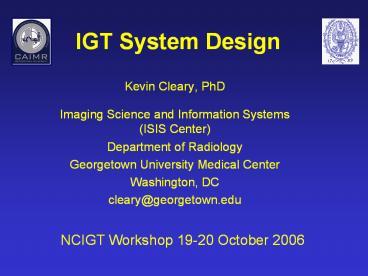IGT System Design - PowerPoint PPT Presentation
1 / 25
Title:
IGT System Design
Description:
Medtronic Stealthlink. Network interface ... Contact: leslie.holton_at_medtronic.com. CAIMR. Georgetown University. Slide 21. Image-Guided Systems ... – PowerPoint PPT presentation
Number of Views:150
Avg rating:3.0/5.0
Title: IGT System Design
1
IGT System Design
- Kevin Cleary, PhD
- Imaging Science and Information Systems (ISIS
Center) - Department of Radiology
- Georgetown University Medical Center
- Washington, DC
- cleary_at_georgetown.edu
NCIGT Workshop 19-20 October 2006
2
Take Home Message
- IGT is a systems engineering problem
- System design / requirements is first step
- Modularity is key
- Component based approach
- Timing is good as field is emerging
- Science of image guidance
- NCIGT can help
- Organization, infrastructure, prototype systems,
and critical mass
3
Outline
- What is an IGT system?
- System design
- Modularity
- Design processes
- Components
- Standards
- Software
- Trackers
- Robots
- Image-guided systems
- Challenges
- How can NCIGT help?
4
OR2020 Examples (or2020.org)
Courtesy of Accuray Inc.
Courtesy of Ferenc Jolesz, MD
Courtesy of Mehran Anvari, MD
Courtesy of Heinz Lemke, PhD
5
What is an IGT System?
- From Workshop web page IGT systems
- Integrated devices for therapy delivery
- Incorporate intra-operative medical imaging,
navigation, or robotics - Compare this with the definition of a system
- Set of interrelated components working together
towards some common objective - Reference Systems Engineering Principles and
Practice, Kossiakoff and Sweet, Wiley, 2003, page
3 - Creating an IGT system
- Systems Engineering job
- Domain knowledge is critical
6
System DesignDefinition
- The process of defining the architecture,
components, interfaces, and other characteristics
of a system or component (page 434) - Requirements are critical to this process
- Obtaining good requirements can be difficult
- Often a weak link in research projects (because
of this difficulty)
7
System Design Modularity
- Essential goal of systems engineering
- High degree of modularity (page 10)
- Critical issue for our field
- Where should we draw these interfaces?
- Poor modularity makes it difficult to integrate
components - Regulatory issues are important
8
Why Cant We Have Modularity for IGT (or can we?)
- Is the domain too complex?
- Many different procedures
- Physician practice varies
- Is the field too young?
- Not enough critical mass
- Science of IGT not mature
- Is it a regulatory problem?
- Or is the timing ripe?
9
One Possible Pathway
- Identify clinically important problems where
image-guided therapy may be useful - Workflow analysis of these procedures
- Develop a requirements specification
- Partition the systems into modules by determining
where the interfaces lie - Implement and test system
10
System Design Processes
- Many traditional life cycle approaches
- These are heavyweight processes
- We want an agile process
- Can an agile process produce a quality product
for the medical domain? - Agile does not imply unmanaged
- Open source software tools may apply
11
Components of an IGT System
- Standards
- Software
- Trackers
- Robotics
- Commercial image-guided systems with accessible
APIs
12
Standards Accuracy Measurement
- ASTM Committee F04.05 on Computer Assisted
Orthopaedic Surgical Systems - WK5350 New Standard Practice for Accuracy
Measurement in Computer-Assisted Orthopedic
Surgery - Scope
- Clinically relevant assessment procedures
- Focus on engineering performance of a system
- http//www.astm.org
13
Standards DICOM WG24
- Scope To develop DICOM objects and services
related to image guided surgery - Roadmap
- Representatives from surgical disciplines
- Establish workflows
- Propose DICOM services
- White paper in progress
- Chair Heinz Lemke, PhD
14
Medical Device "Plug-and-Play" Interoperability
Program
- Goal standardizing medical device connectivity
- Based at CIMIT and Massachusetts General
- Standard under development
- Integrated Clinical Environment Manager
- Vendor neutral laboratory sandbox
- http//mdpnp.org/
15
SoftwareIGSTK Image-Guided Surgical Toolkit
16
(No Transcript)
17
SoftwareSIGN Slicer Image-Guided Navigator
- Source http//www.ncigt.org/sign/documentation/in
dex.html
18
TrackersState of the Art
- APIs are available
- Optical trackers
- Electromagnetic trackers
- Software libraries are available
- Open tracker
- Can be easily integrated
19
RobotsState of the Art
- Situation is more complicated
- No commercial robot for medical market exists
with a defined API - Robotic systems tend to change clinical procedure
more than image guidance - This is a challenge for the future
20
Image-Guided SystemsMedtronic Stealthlink
- Network interface
- Allows data flow from image-guided system
Stealthstation to your application in real-time - Provides an application program interface (API)
- Contact leslie.holton_at_medtronic.com
21
Image-Guided SystemsBrainlab VectorVision Link
- Network interface
- Allows data flow
- Provides an API
- Based on VTK
- Can create custom views and display on
VectorVision workstation - Contact robert.lucht_at_brainlab.com
22
Summary of Components
- Components are becoming available
- More standardization is needed
- Analysis of clinical procedures would be useful
to determine commonality (back to requirements
definition) - Architecture and interfaces are key
- This group could help!
23
Three challenges
- Do a better job at defining the requirements
- Image-guided systems can be complex
- Should we define multiple types of systems based
on difficult clinical requirements? - This should help define components and
architecture - Providing a rationale to convince manufacturers
that they should always provide an API (like
DICOM is now standard for images) - Creating standards (can be difficult and time
consuming)
24
How can NCIGT help?
- By providing a forum where researchers can
discuss these issues - By developing a testbed or prototype system that
multiple researchers can contribute to - By developing an open architecture and modular
components
25
Thank you for your attention!

